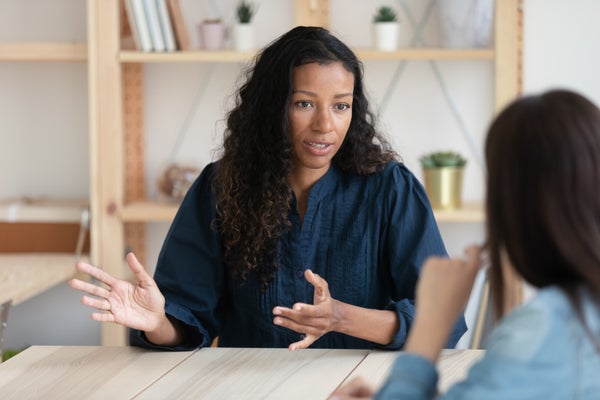When learning a foreign language, most people fall back on traditional methods: reading, writing, listening and repeating. But if you also gesture with your arms while studying, you can remember the vocabulary better, even months later. Linking a word to brain areas responsible for movement strengthens the memory of its meaning. This is the conclusion a research team reached after using magnetic pulses to deliberately disrupt these areas in language learners. “Our results provide neuroscientific evidence for why learning techniques that involve the body’s motor system should be used more often,” neuroscientist Brian Mathias, of the Max Planck Institute for Human Cognitive and Brain Sciences in Leipzig, said in a news release.
As Mathias and his colleagues describe in the Journal of Neuroscience, they had 22 German-speaking adults learn a total of 90 invented artificial words (such as “lamube” for “camera,” and “atesi” for “thought”) over four days. While the test subjects first heard the new vocabulary, the were simultaneously shown a video of a person making a gesture that matched the meaning of the word. When the word was repeated, the subjects performed the gesture themselves.
Five months later, they were asked to translate the vocabulary they had learned into German in a multiple-choice test. At the same time, they had an apparatus attached to their heads that sent weak magnetic pulses to their primary motor cortex—the brain area that controls voluntary arm movements. When these interfering signals were active, the subjects found it harder to recall the words accompanied by gestures. When the apparatus sent no interfering signals (but still appeared to the subjects to be active), they found it easier to remember the words. The researchers concluded that the motor cortex contributed to the translation of the vocabulary learned with gestures. This applied to concrete words, such as “camera,” as well as abstract ones, such as “thought.”
On supporting science journalism
If you're enjoying this article, consider supporting our award-winning journalism by subscribing. By purchasing a subscription you are helping to ensure the future of impactful stories about the discoveries and ideas shaping our world today.
“There’s now quite a lot of literature showing that gestures play a role in learning. I think where this study takes it a step further is trying to understand why,” says Susan Goldin-Meadow, a psychologist at the University of Chicago who studies the effects of gestures on learning but was not involved in the new study. Research like this, as well as brain imaging, suggests the activation of the brain’s motor areas could be a factor. “It’s not necessarily the only reason why,” Goldin-Meadow adds, “but it’s probably a contributor.”
The effect did not occur when the test subjects were only presented with matching pictures instead of gestures when learning vocabulary. In contrast, children—unlike adults—seem to benefit from pictures as much as gestures in the long run. In an experiment published in 2020, the Leipzig research group had young adults and eight-year-old children listen to new vocabulary for five days, sometimes paired with matching pictures or videos of gestures. After two months, the two methods were still tied. But after six months, the adults benefited more from the gestures than the pictures, while the children were helped equally by both.
The study indicates that the adult brain uses motor areas to remember foreign-language words. But it is not only the motor component itself that promotes learning. The intrinsic meaning of the gesture also figures in, as another team led by Mathias’s colleague Manuela Macedonia observed several years ago. That older study suggested that gestures particularly promote the memory of words if they represent the meaning of the word pictorially.
Back in 1995, a study showed that such emblematic gestures facilitated French-language learning. Even transferring the words to a new context worked better: When learners accompanied the new vocabulary with gestures, they were more likely to use the words in new sentences.
“I think we underuse gesture in our classrooms,” Goldin-Meadow says. “People use it spontaneously, if they’re good teachers and good listeners, but we don’t necessarily bring it into the class if we don’t think about it—and it could be used more often and more effectively.”
This article originally appeared in Spektrum der Wissenschaft and was reproduced with permission.
